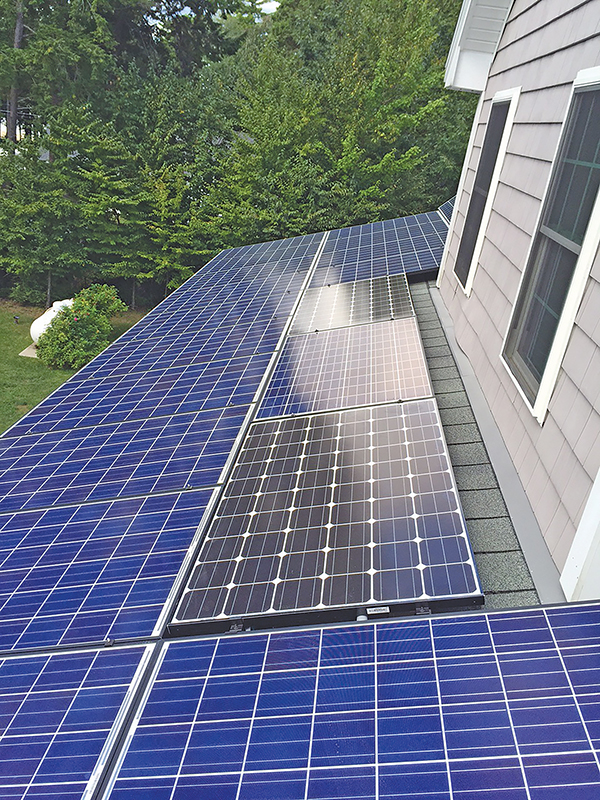 Payback for a solar PV system may seem long, but you have to buy electricity from somewhere. Installing a solar PV system is like buying your own little power plant; once you’ve paid yourself back for your investment, there’s no more cost for your electric power.
Payback for a solar PV system may seem long, but you have to buy electricity from somewhere. Installing a solar PV system is like buying your own little power plant; once you’ve paid yourself back for your investment, there’s no more cost for your electric power.
Your contractor/supplier can show you the probable estimated output and estimated payback and cash flow from your solar PV system.
Maine utilities, like utilities in most states, are required to provide “net metering.” With net metering, customers are credited for each kwh produced by their system.
Like rollover minutes on a cell phone plan, net metering means you can generate and store your solar electricity for future use.
Although the Maine PUC has recently announced changes to net metering, you will still be credited for about 90 percent of the retail price of a kilowatt hour (kWh) for each kWh that your system exports to the grid.
How does it work?
The systems use PV panels to generate DC electricity; inverters change the DC current into AC. The main components in a solar electric system are the panels and the inverters.
Is it right for my property?
 With a copy of your electric bill and your property’s physical address, Goggin Energy uses Google Earth to assess whether your roof will allow for solar PV. If your roof is not in good shape or does not receive enough sun, a pole mount or ground mount system might be appropriate for you.
With a copy of your electric bill and your property’s physical address, Goggin Energy uses Google Earth to assess whether your roof will allow for solar PV. If your roof is not in good shape or does not receive enough sun, a pole mount or ground mount system might be appropriate for you.
A south-facing roof is best, but southeast and southwest locations can also work. If you want a roof mounted system (the most economical mounting system) your roof should be in good shape and have at least 5 to 10 years of life left on it.
What type of panels are best?
Many reputable brands offer high-quality panels, but California-based SunPower manufactures the world’s most efficient solar panels. They are carried by several Maine dealers, including Goggin Energy.
SunPower panels cost a little more per watt than other panels, but they have many advantages, including offering the longest warranty of any panel and being an excellent choice for locations with a limited amount of space for a solar array.
SunPower panels also have a higher output 25 years out than conventional panels, are more resistant to damage, and have a higher output even when blocked by shade and dirt.
Solar inverters
Two types of inverters are used in a solar electric system: string inverters and micro-inverters.
String inverters act like an old string of Christmas lights: all are connected, and if one has a problem, the output of the entire system is compromised.
Micro-inverters, on the other hand, are individually mounted behind each solar panel and change the current from DC to AC at the site of each panel.
There are pros and cons of each type of inverter (upfront cost, life of equipment, shading, matching with panel output, etc.) Be sure to know which type of inverter you are being quoted.
Monitoring
Monitoring is highly recommended. A monitor allows you to see on the monitoring company’s website the output of your system and, in the case of micro inverters, if all panels are producing electricity and if there are issues with any panel.
When looking at the cost of solar electric installations, you should be clear on whether monitoring equipment is included (the ongoing cost of monitoring is usually, but not always, included for residential systems at no annual charge).
For more information on Goggin Energy (on Free Street in Portland,) please visit www.gogginenergy.com.
Copy the Story LinkSend questions/comments to the editors.



Success. Please wait for the page to reload. If the page does not reload within 5 seconds, please refresh the page.
Enter your email and password to access comments.
Hi, to comment on stories you must . This profile is in addition to your subscription and website login.
Already have a commenting profile? .
Invalid username/password.
Please check your email to confirm and complete your registration.
Only subscribers are eligible to post comments. Please subscribe or login first for digital access. Here’s why.
Use the form below to reset your password. When you've submitted your account email, we will send an email with a reset code.